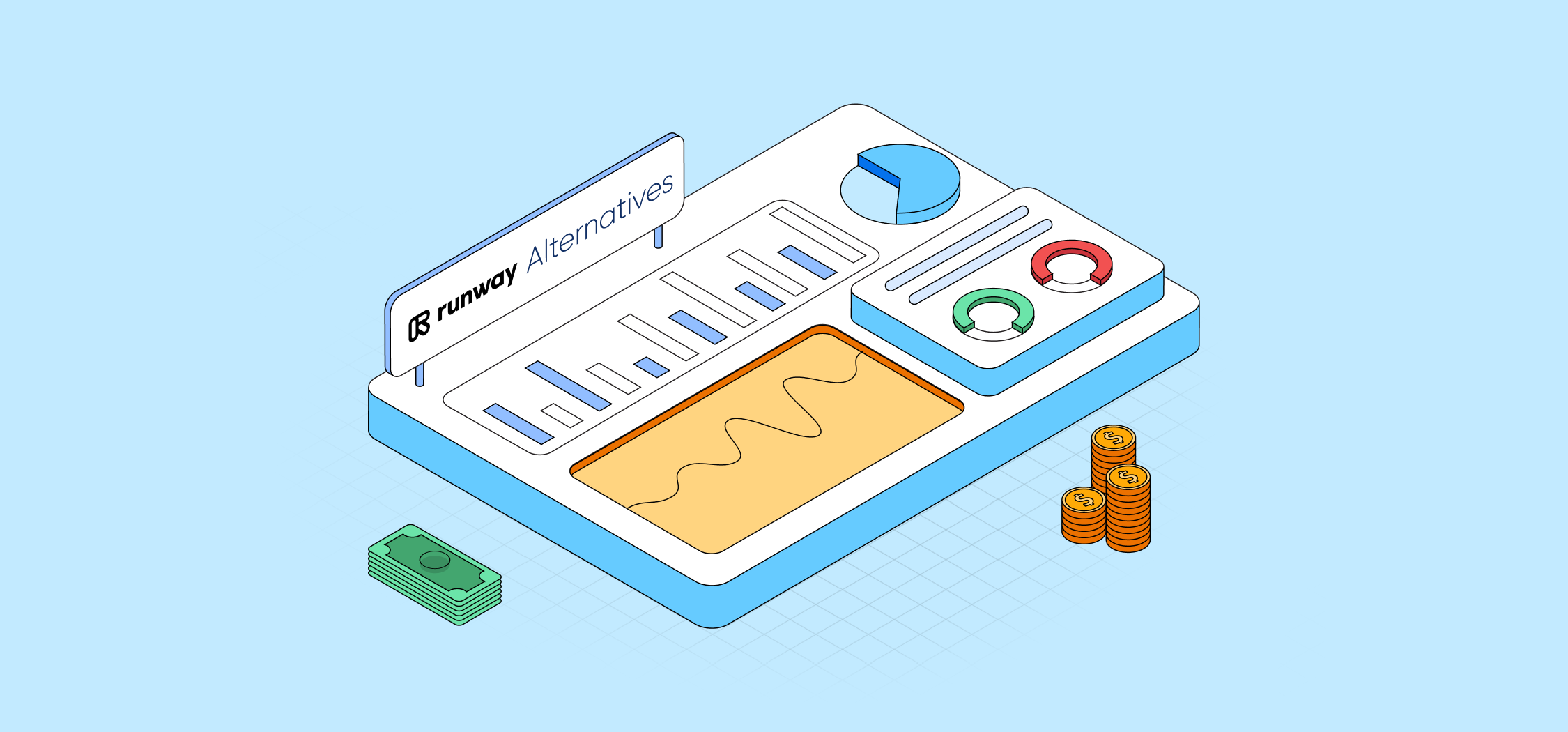Runway is popular for its clean design and quick time-to-value, but many finance teams outgrow it once reporting, modeling, and automation needs become more complex. In this guide, we compare the top Runway alternatives for 2026 drawing on customer reviews and feedback and vendor documentation to determine where each tool delivers and where it falls short. At the end, you’ll have a clearer view of best-fit FP&A solutions for your business.
Runway has built a reputation as a design-forward FP&A platform for fast-moving companies, praised for its clean interface, quick time-to-value, and wide range of integrations. But, cost pressures, scalability limits, and the absence of mature AI-driven automation often compels teams to explore alternatives.
That’s why we reviewed the market to identify the top Runway alternatives for 2026. To make this guide useful, we’ve structured it around what really matters by:
- Looking closely at features: We examined how tools perform on critical FP&A tasks like automated reporting packs, scenario and headcount modeling, cash flow forecasting, and variance analysis.
- Focusing on finance-specific requirements: Our review centers on what CFOs and FP&A leaders tell us they care about most — integration stability and breadth, model scalability, AI maturity, and the quality of customer support.
- Being real about strengths and limits: Runway earns praise for usability, speed, and customer service, but users also flag performance slowdowns, formula complexity, and limited AI. Each alternative we cover addresses different parts of that trade-off.
- Hearing from real users: Beyond vendor promises, we’ve combed through G2 reviews, Reddit discussions, analyst insights, and vendor documentation to give you a clear, data-driven comparison of what each platform actually delivers day to day.
Whether you’re switching from Runway or considering it as your first FP&A solution, this guide will show you how the leading options stack up so you can choose your next tool that’ll scale with you instead of forcing another replatform in two years.
Let's start with a review of Runway
- Price: $$
- Best for: Startups and SMBs (50–200 employees)
Runway is a FP&A platform built for fast-moving SMBs and mid-market companies. Praised for its clean interface, quick time-to-value, and wide integrations with systems like NetSuite, Rippling, Ramp, and QuickBooks, it’s often the first step for finance teams moving beyond spreadsheets.
That said, G2 reviewers highlight that Runway’s ease of use has limits. As models grow more complex, users mention performance slowdowns, formula customization challenges, and the absence of AI-driven automation for forecasting and analysis.
Key features
Runway was developed to simplify FP&A for smaller teams and includes:
- Real-time integrations: Direct connections to ERP, payroll, and expense systems to reduce manual data entry.
- Scenario and headcount modeling: Flexible toggles to test hiring, churn, and fundraising assumptions.
- Visual dashboards and reporting: Clean, board-ready outputs with BvA analysis.
- Collaboration and permissions: Tailored views for leadership and department heads.
- Spreadsheet-like interface: Familiar logic for teams used to Excel or Google Sheets.
Pros
- Intuitive UI and fast onboarding
- Wide range of integrations (NetSuite, Ramp, Rippling, QBO)
- Responsive, “white glove” customer support
- Quick time-to-value (weeks, not months)
- Easy sharing of financial views with tailored access
Cons
- Performance slows with complex or large models
- Advanced modeling requires SQL knowledge
- Limited AI-capabilities (still under beta)
- Dependence on support for ongoing changes
- Considered pricey for smaller SMB budgets
Runway's top 9 competitors in the FP&A software market
1. Drivetrain
- Price: $$
- Best for: Mid-market and Enterprises
Drivetrain is an AI-native FP&A platform built to help finance teams move beyond the firefighting spreadsheets often require into friction-free continuous planning. On G2, it consistently ranks #1 for ease of use. Customers highlight three areas where Drivetrain stands out: its breadth of integrations, its AI-powered workflows, and its rapid onboarding.
For finance leaders frustrated with hitting ceilings in other platforms, Drivetrain offers a “grow with you” architecture, making it equally appealing to CFOs looking for faster board reporting today and FP&A leaders planning for scalability tomorrow.
Key FP&A features
- 800+ no-code integrations: Real-time sync across ERP, CRM, HRIS, billing, BI, and data warehouses.
- Spreadsheet interoperability: Native Excel/Google Sheets connections with push/pull functionality.
- Driver-based & scenario modeling: Multi-dimensional, plain-English logic with granular version control.
- AI-powered workflows: Automated scenario generation, anomaly detection, variance explanations, close/reporting automations.
- Predictive forecasting: Built-in forecasting methods with real-time actuals ingestion.
- Governance & security: Role-based access control (RBAC), audit trails, and model lineage.
- Board-ready reporting: Automated reporting templates and dynamic dashboards for executives and investors.
- Fast onboarding: Guided implementation with high-touch support, often live in 4–6 weeks.
2. Mosaic
- Price: $$
- Best for: SMBs and Mid-market
Mosaic is more of a BI than FP&A software, with a focus on dashboards, KPIs, and fast time-to-value. It’s best for teams that need visibility more than deep modeling flexibility.
Mosaic’s template-first approach can be rigid for those needing more flexibility to customize.Also, its integration catalog isn’t as extensive as some of the other platforms on this list. Despite these limitations, Mosaic may be a good fit for smaller companies that need more than what their spreadsheets can provide but aren’t yet ready for the complexity of enterprise FP&A.
Key features & benefits
- Prebuilt dashboards & KPIs: Get visibility fast, reducing manual reporting effort.
- Scenario modeling: Simple visual editors make it easy to test assumptions.
- Collaboration tools: Department leaders can contribute inputs without finance-heavy skills.
- Automated imports: Reduce errors from manual data pulls.
- Custom reports: Tailor insights for executives, saving time in board prep.
3. Cube
- Price: $$
- Best for: SMBs and Mid-market
Cube sits on top of Excel and Google Sheets, pairing their familiarity with added automation and governance. Because Cube relies on spreadsheets, it shares the same limitations when it comes to scale. Users report performance issues with large data sets and drill-down capabilities are limited.
However, it can be a strong fit for small finance teams that need quick time-to-value without heavy retraining.
Key features & benefits
- Spreadsheet-native workflows: Keep working in Excel/Sheets but eliminate fragile links, reducing errors.
- Automated consolidation: Pulls data from source systems into one model, saving hours of manual reconciliation.
- Multi-scenario planning: Quickly test assumptions (e.g., hiring or sales shifts) to guide decision-making.
- Audit & controls: Change tracking and approvals boost accuracy and accountability.
- Collaboration: Role-based tasks and approvals make budgeting more transparent.
4. Datarails
- Price: $$
- Best for: SMBs and Mid-market
Datarails lets finance teams keep their Excel models while automating consolidation, controls, and reporting. Datarails won't scale like a purpose-built FP&A system. However, it does add AI features, such as error detection and an AI assistant that can provide fast answers and create quick visuals.
It’s attractive to teams not ready to rebuild models in new software but still seeking efficiency gains and AI capabilities without having to leave Excel.
Key features & benefits
- Excel-native modeling: Preserve existing models and formulas, avoiding steep learning curves.
- Automated consolidation & reporting: Replaces manual file rollups, accelerating monthly close.
- Variance & error detection: AI flags anomalies instantly, reducing costly mistakes.
- Drill-down capabilities: Trace KPIs back to source data for stronger insights.
- Prebuilt reports: Schedule and distribute financial packages quickly, saving reporting cycles.
5. Planful
- Price: $$
- Best for: Mid-market
Planful offers a mature, end-to-end FP&A solution built for organizations with strict governance requirements. It automates budgeting, forecasting, and financial reporting, and provides workflow controls and documentation needed to ensure compliance.
Planful offers a powerful AI-driven forecasting that reduces manual fine-tuning of complex models and catches forecast anomalies. However, implementation can be complex and usually requires IT and/or third party support to get it up and running well.
Key features & benefits
- Close & consolidation automation: Accelerates period-end processes, reducing errors.
- Forecasting & budgeting templates: Standardizes processes, improving consistency.
- Workflow & audit trails: Ensures accountability, helping with regulatory needs.
- Scenario planning: Models long-term outcomes for strategic choices.
- Integrations: Links to ERPs/CRMs for a single financial view.
6. Vena
- Price: $$
- Best for: Mid-market organizations standardized on Microsoft Excel
Vena extends Excel with a structured backend for governance, workflows, and reporting. It’s strong for teams used to working in the Microsoft ecosystem and leverages Microsoft’s Copilot to speed up analysis.
It can take longer to implement than some of the other options here and, like other Excel-based solutions, it does inherit Excel’s limitations. However, it is a good fit for teams strongly wed to their Excel models.
Key features & benefits
- Excel add-in: Keep familiar modeling while gaining structure.
- Preconfigured FP&A package: Speeds setup of budgeting and forecasting.
- Workflow management: Tracks approvals and comments, improving accountability.
- Audit-ready reporting: Reduces compliance risk.
- Regulatory support: Ensures reporting meets external standards.
7. Abacum
- Price: $$
- Best for: Mid-market businesses
Abacum is a cloud-based FP&A tool designed to provide collaborative workflows combined with AI capabilities that enable rapid generation of forecasts and anomaly detection.
Abacum offers a user-friendly design that makes financial planning smoother and more collaborative. However, the platform also comes with a steeper learning curve to ensure optimal implementation and customization.
Key features & benefits
- Real-time collaboration: In-app comments and chats reduce back-and-forth emails.
- Custom drivers & KPIs: Business teams can adapt assumptions without breaking models.
- Automated consolidation: Eliminates error-prone manual merges.
- Dashboards for stakeholders: Simplifies reporting for department heads.
- Centralized formula library: Keeps metrics consistent across the org.
8. Aleph
- Price: $
- Best for: SMBs
Aleph uses a bidirectional integration with Excel to enhance and centralize Excel-based modeling rather than replace it entirely. Aleph’s approach allows users to access its functionality entirely through its web interface or continue to work with live data within Excel.
Aleph does offer some standalone modeling capabilities through its web platform and includes no-code dashboards and data visualizations. However, its main appeal is for teams seeking automated data synchronization, real-time updates, and centralized data management as opposed to robust FP&A capabilities.
Key features & benefits
- Excel/Sheets plug-ins: Keep familiar workflows, reducing training.
- 200+ no-code connectors: Rapid setup, saving IT effort.
- AI/automation tools: Flag outliers and prep board-ready reports, saving time.
- Centralized reporting: Live data makes outputs more reliable.
- Lightweight permissions: Provide basic governance without complexity.
9. Fathom
- Price: $-$$
- Best for: SMBs
Fathom positions itself as a management reporting, analysis, forecasting, consolidation, and benchmarking tool built to make financial insights accessible.
It offers strong cash-flow forecasting and basic scenario planning. However, users have noted that Fathom’s modeling features can feel rigid with limitations in terms of creating complex formulas.
Key features & benefits
- Automated management reports: Save hours creating recurring packs.
- Cash flow forecasting: Improves visibility into short- and mid-term liquidity.
- Multi-entity consolidation: Handles subsidiaries and currencies with ease.
- Benchmarking: Compare units or clients quickly.
- Dashboards: Communicate insights visually to non-finance stakeholders.
How to choose the best Runway alternative
Choosing an FP&A platform is less about who has the flashiest dashboard and more about fit: Does the tool solve the problems you’re facing today, and will it still fit when your business doubles in size?
Runway is popular because it makes reporting and modeling feel easier in the short term, but you might need re-platforming when they hit limits in automation, scalability, or governance. To avoid the same trap, it helps to approach vendor evaluation with a structured scorecard.
Start with your non-negotiables. Most CFOs and FP&A leaders we speak with emphasize four categories:
- Modeling depth: Can it handle the scenarios you actually run (multi-entity, headcount plans, revenue drivers) without breaking?
- Time to value: How quickly can you get to your first reliable board pack or scenario run — weeks, or months?
- Ease of use and adoption: Will your finance team, and ideally department leaders, be able to use it without constant support?
- Integration stability: Does data flow reliably from ERP, payroll, and CRM into one source of truth?
Once you’ve defined those priorities, put each vendor through the same test. A practical way to do this is to:
- Run the scorecard on Runway and other alternatives. Use the same input slice; the last two quarters of actuals, open pipeline, and your current headcount plan to keep comparisons fair.
- Ask each vendor to rebuild a live scenario you care about. A good example: “Hiring freeze + 10% ACV uplift + slip on enterprise deals.” This forces the platform (and the vendor team) to show how easily it adapts to your reality, not just a demo dataset.
- Assess beyond features. Look at vendor culture, roadmap, and responsiveness. As one Redditor put it, “You’re not just buying what they’ve built today… you’re betting on whether they’ll keep fixing bugs and improving over time.”
When scoring options, think of fit with a simple rubric:
Fit = (Modeling depth you’ll actually use) × (Time to value) ÷ (Team capacity).
This keeps the focus on what matters most: Can your team realistically adopt and maintain the tool, and will it give you leverage in the next planning cycle?
Some platforms will be a good fit for businesses that need an alternative to their Excel spreadsheets while others might not be quite ready to give them up and need something to make them more usable and reliable for FP&A. Ultimately though, any growing business will start bumping into the limitations inherent in spreadsheets, even with platforms that extend their capabilities.
If you want to avoid replatforming down the road, it’s a good idea to take a closer look at Drivetrain. As a powerful, yet simple AI-native FP&A software, Drivetrain balances the quick time-to-value you’d expect from a Runway-style tool with the deeper modeling and scenario rigor and speed you’ll need as your business grows.
.png)

With hundreds of integrations and fast onboarding, Drivetrain gives finance teams both immediate relief and long-term scalability—which is what makes it stand out as the best alternative to Runway in the market for high-growth companies.
Want to see for yourself? Contact us to book a demo today.
Frequently asked questions
In addition to license costs, your budget should also include the cost of any implementation services, internal time (model rebuilds, training), and ongoing admin. If you rely on niche systems, factor in data engineering as well.
Lightweight tools deliver quick wins but may become costly as needs expand. Platforms with deeper automation and governance often deliver lower long-run cost per planning cycle by cutting manual effort.
The number of integrations are important. The more a platform offers, the greater the likelihood that it will be able to connect with the systems you use now and any you might use in the future as your business grows. For example, Drivetrain offers 800+ native integrations, plus the ability to create custom integrations if you need one.
Reliability matters, too. Here are four things you should confirm when evaluating FP&A software:
- The systems you currently use are natively supported
- What the refresh frequency is and whether it is event-based or batched
- Whether bidirectional sync is available for the systems you need to integrate
- How schema changes are handled.
Adoption hinges on UI and role-based design. If department heads need to enter plans, prioritize platforms like Drivetrain, that offer intuitive dashboards, role-specific views, and in-app collaboration features. If finance owns the models and only shares outputs, spreadsheet-native tools may be enough.
Baseline requirements for any modern FP&A software include SSO, fine-grained role-based access controls (RBAC), audit trails, encryption (at rest and in transit), and environment segregation (dev/test/prod). Export logging is also key. For regulated industries, look for SOC 2 certification and data residency options.

.svg)






.webp)



.svg)

